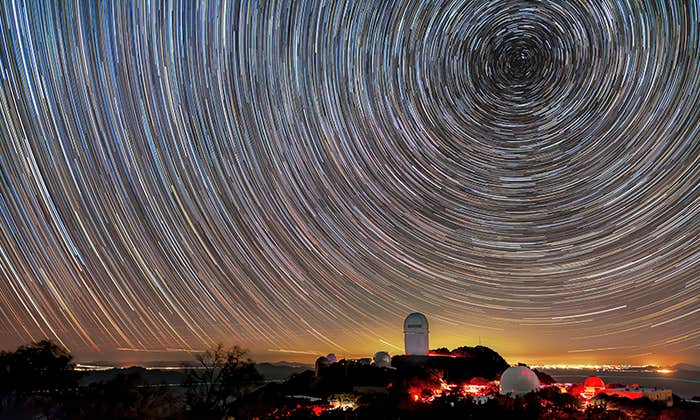On recent estimates, the observable universe—the portion of the universe that we can detect through our telescopes—extends about 47 billion light-years in every direction. But the limit of what we can see is one thing, and the limit of what exists is quite another. It would be remarkable if the universe stopped exactly at the edge of what we can see. For one thing, that would place us, surprisingly and un-Copernicanly, precisely at the center.
But even granting that the universe is likely to be larger than 47 billion light-years in radius, it doesn’t follow that it’s infinite. It might be finite. But if it’s finite, then one of two things should be true: Either the universe should have a boundary or edge, or it should have a closed topology.
It’s not absurd to think that the universe might have an edge. Theoretical cosmologists routinely consider hypothetical finite universes with boundaries at which space comes to a sudden end. However, such universes require making additional cosmological assumptions for which there is no direct support—assumptions about the conditions, if any, under which those boundaries might change, and assumptions about what would happen to objects or light rays that reach those boundaries.
A finite universe might have boundaries at which space comes to a sudden end.
It’s also not absurd to think that the universe might have a closed topology. By this we mean that over distances too large for us to see, space essentially repeats, so that a particle or signal that traveled far enough would eventually come back around to the spatial region from which it began—like how when Pac-Man exits one side of the TV screen, he re-emerges from the other side. However, there is currently no evidence that the universe has a closed topology.
Leading cosmologists, including Alex Vilenkin, Max Tegmark, and Andrei Linde, have argued that spatial infinitude is the natural consequence of the best current theories of cosmic inflation. Given that, plus the absence of evidence for an edge or closed topology, infinitude seems a reasonable default view. The mere 47 billion light-years we can see is the tiniest speck of a smidgen of a drop in an endless expanse.
Let’s call any galaxy with stars, planets, and laws of nature like our own a sibling galaxy. Exactly how similar a galaxy must be to qualify as a sibling we will leave unspecified, but we don’t intend high similarity. Andromeda is sibling enough, as are probably most of the other hundreds of billions of ordinary galaxies we can currently see.
The finiteness of the speed of light means that when we look at these faraway galaxies, we see them as they were during earlier periods in the universe’s history. Taking this time delay into account, the laws of nature don’t appear to differ in regions of the observable universe that are remote from us. Likewise, galaxies don’t appear to be rarer or differently structured in one direction or another. Every direction we look, we see more or less the same stuff. These observations help motivate the Copernican Principle, which is the working hypothesis that our position in the universe is not special or unusual—not the exact center, for example, and not the one weird place that happens to have a galaxy operating by special laws that don’t hold elsewhere.
Still, our observable universe might be an atypical region of an infinite universe. Possibly, somewhere beyond what we can see, different forms of elementary matter might follow different laws of physics. Maybe the gravitational constant is a little different. Maybe there are different types of fundamental particles. Even more radically, other regions might not consist of three-dimensional space in the form we know it. Some versions of string theory and inflationary cosmology predict exactly such variability.
But even if our region is in some respects unusual, it might be common enough that there are infinitely many other regions similar to it—even if just one region in 10500. Again, this is a fairly standard view among speculative cosmologists, which comports well with straightforward interpretations of leading cosmological theories. One can hardly be certain, of course. Maybe we’re just in a uniquely interesting spot! But we are going to assume that’s not the case. In the endless cosmos, infinitely many regions resemble ours, with three spatial dimensions, particles that obey approximately the “Standard Model” of particle physics, and cluster upon cluster of sibling galaxies.
Under the assumptions so far, the Copernican Principle suggests that there are infinitely many sibling galaxies in a spacelike relationship with us, meaning that they exist in spatiotemporal regions roughly simultaneous with ours (in some frame of reference). We will have seen the past history of some of these simultaneously existing sibling galaxies, most of which, we assume, continue to endure. However, it’s a separate question whether there are also infinitely many sibling galaxies in a timelike relationship to us—more specifically, existing in our future. Are there infinitely many sibling galaxies in spatiotemporal locations that are, at least in principle, eventually reachable by particles originating in our galaxy? (If the locutions of this paragraph seem convoluted, that’s due to the bizarreness of relativity theory, which prevents us from using “past,” “present,” and “future” in the ordinary, commonsense way.)
Thinking about whether infinitely many sibling galaxies will exist in the future requires thinking about heat death. Stars have finite lifetimes. If standard physical theory is correct, then ultimately all the stars we can currently see will burn out. Some of those burned-out stars will contribute to future generations of stars, which will, in turn, burn out. Other stars will become black holes, but then those black holes also will eventually dissipate (through Hawking radiation).
Given enough time, assuming that the laws of physics as we understand them continue to hold, and assuming things don’t re-collapse in a “Big Crunch” in the distant future, the standard view is that everything we presently see will inevitably enter a thin, boring, high-entropy state near equilibrium—heat death. Picture nearly empty darkness, with particles more or less evenly spread out, with even rock-size clumps of matter being rare.
But what happens after heat death? This is of course even more remote and less testable than the question of whether heat death is inevitable. It requires extrapolating far beyond our current range of experience. But still we can speculate based on currently standard assumptions. Let’s think as reasonably as we can about this. Here’s our best guess, based on standard theory, from Ludwig Boltzmann through at least some time slices of Sean Carroll.
The universe might collapse upon itself in a Big Crunch, followed by another Big Bang.
For this speculative exercise, we will assume that the famously probabilistic behavior of quantum systems is intrinsic to the systems themselves, persisting post-heat-death and not requiring external observers carrying out measurements. This is consistent with most current approaches to quantum theory (including most many-worlds approaches, objective-collapse approaches, and Bohmian mechanics). It is, however, inconsistent with theories according to which the probabilistic behavior requires external observers (some versions of the “Copenhagen interpretation”) and theories on which the post-heat-death universe would inescapably occupy a stationary ground state. Under this assumption, standard probabilistic theories of what happens in high-entropy, near-vacuum conditions continue to apply post-heat-death. More specifically, the universe will continue to support random fluctuations of photons, protons, and whatever other particles remain. Consequently, from time to time, these particles will, by chance, enter unlikely configurations. This is predicted by both standard statistical mechanics and standard quantum mechanics. Post-heat-death, seven particles will sometimes converge, by chance, upon the same small region. Or 700. Or—very rarely!—7 trillion.
There appears to be no in-principle limit to how large such chance fluctuations can be or what they can contain if they pass through the right intermediate phases. Wait long enough and extremely large fluctuations should occur. Assuming the universe continues infinitely, rather than having a temporal edge or forming a closed loop, for which there is no evidence, then eventually some random fluctuation should produce a bare brain having cosmological thoughts. Wait longer, and eventually some random fluctuation will produce, as Boltzmann suggested, a whole galaxy. If the galaxy is similar enough to our own, it will be a sibling galaxy. Wait still longer, and another sibling galaxy will arise, and another, and another …
For good measure, let’s also assume that after some point post-heat-death, the rate at which galaxy-size systems fluctuate into existence does not systematically decrease. There’s some minimal probability of galaxy-size fluctuations, not an ever-decreasing probability with longer and longer average intervals between galaxies. Fluctuations appear at long intervals, by random chance, then fade back into chaos after some brief or occasionally long period, and the region returns to the heat-death state, with the same small probability of large fluctuations as before. Huge stretches of not much will be punctuated by rare events of interesting, even galaxy-size, complexity.
Of course, this might not be the way things go. We certainly can’t prove that the universe is like this. But despite the bizarreness that understandably causes some people to hesitate, the overall picture we’ve described appears to be the most straightforward consequence of standard physical theory, taken out of the box, without too much twisting things around.
Even if this specific speculation is wrong, there are many other ways in which the cosmos might deliver infinitely many sibling galaxies in the future. For example, some process might ensure we never enter heat death and new galaxies somehow continue to be born.
Alternatively, processes occurring pre-heat-death, such as the formation of black holes, might lead to new bangs or cosmic inflations, spatiotemporally unconnected or minimally connected to our universe, and new stars and galaxies might be born from these new bangs or inflations in much the same way as our familiar stars and galaxies were born from our familiar Big Bang.
Depending on what constitutes a “universe” and a relativistically specifiable “timelike” relation between our spatiotemporal region and some future spatiotemporal region, those sibling galaxies might not exist in our universe or stand in our future, technically speaking, but if so, that detail doesn’t matter to our core idea. Similarly, if the observable universe reverses its expansion, it might collapse upon itself in a Big Crunch, followed by another Big Bang, and so on in an infinitely repeating cycle, containing infinitely many sister galaxies post-Crunch. This isn’t currently the mainstream view, but it’s a salient and influential alternative if the heat-death scenario outlined above is mistaken.
We conclude that it is reasonable to think that the universe is infinite, and that there exist infinitely many galaxies broadly like ours, scattered throughout space and time, including in our future. It’s a plausible reading of our cosmological situation. It’s a decent guess and at least a possibility worth taking seriously. ![]()
Excerpted from The Weirdness of the World © 2024 by Eric Schwitzgebel. Reprinted by permission of Princeton University Press.
Lead image: NASA
































